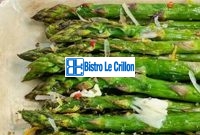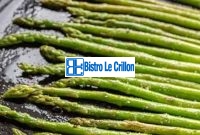Are you ready to become a master in the kitchen? Cooking asparagus on the stovetop is a skill that every home cook should have in their arsenal. Not only is it a versatile vegetable that can be enjoyed in a variety of dishes, but it’s also packed with nutrients and brings a vibrant touch to your plate. Whether you’re a beginner or a seasoned chef, mastering the art of cooking asparagus on the stovetop will elevate your culinary prowess to new heights. In this article, we’ll guide you through the process step-by-step, providing helpful tips and tricks along the way. So grab your apron and let’s get cooking!

Understanding Asparagus
Asparagus is a highly versatile vegetable that can be cooked in a variety of ways. It is a member of the lily family and is known for its long, spear-like shape and vibrant green color. This vegetable has a distinctive flavor that is both earthy and slightly bitter. Whether you roast it, grill it, or steam it, asparagus can be a delicious addition to any meal.
What is Asparagus
Asparagus is a perennial flowering plant that is native to Europe, Northern Africa, and Western Asia. It has been cultivated for thousands of years and has become a popular vegetable in many cuisines around the world. The most common variety of asparagus is green in color, but there are also white and purple varieties available. The white asparagus is grown underground, which prevents it from developing chlorophyll and gives it a milder taste compared to the green variety. Purple asparagus is sweeter and more tender than the other varieties.
Health Benefits of Asparagus
Asparagus is not only delicious but also packed with nutrients that can benefit your health. It is a good source of fiber, vitamins A, C, E, and K, as well as folate. Asparagus is also rich in antioxidants, which can help protect your cells against damage caused by free radicals. It is low in calories and contains no fat, making it an excellent choice for those watching their weight. Additionally, asparagus has diuretic properties that can help flush out excess fluid and toxins from your body.
When consumed regularly, asparagus has been linked to several health benefits. It may help improve digestion, reduce the risk of certain types of cancer, and support healthy brain function. Asparagus is also believed to have anti-inflammatory properties that can help relieve symptoms of arthritis and other inflammatory conditions. Its high fiber content can promote a healthy digestive system and prevent constipation.
Choosing the Best Asparagus
When selecting asparagus, it’s important to choose fresh, vibrant stalks. Look for spears that are bright green in color and have firm, closed tips. Avoid any that appear wilted or have a slimy texture. The thickness of the asparagus is a matter of personal preference; thin spears tend to be more tender, while thick spears have a heartier texture. Additionally, you can tell if asparagus is fresh by examining the cut ends – they should be moist and not dried out.
To ensure the best flavor and texture, it is recommended to use the asparagus as soon as possible after purchasing. If you need to store it, wrap the ends in a damp paper towel and place them in a plastic bag in the refrigerator. Asparagus is best consumed within a few days of purchase to preserve its freshness.
Now that you understand the basics of asparagus and its versatile nature in cooking, you’re ready to explore the many delicious ways to prepare this nutritious vegetable!
Preparation and Cleaning
Before you embark on your journey to master the art of cooking asparagus on the stovetop, it is essential to properly prepare and clean this delightful vegetable. This step ensures that you have the freshest and most flavorful asparagus to work with. Follow the steps below to get started.
Trimming and Removing Ends
The first step in preparing asparagus is trimming and removing the tough ends. To do this, take a spear of asparagus and hold it near the bottom. Gently bend the spear until it naturally snaps. This breaking point indicates where the tender part begins and the tough end ends. Alternatively, you can also use a knife or vegetable peeler to trim the ends by cutting off about an inch from the bottom.
Washing and Drying Asparagus
Once the tough ends are removed, it’s time to give your asparagus a good wash. Fill a large bowl or basin with cold water and place the asparagus spears inside. Swirl them around gently to remove any dirt or impurities. After washing, pat the spears dry with a clean kitchen towel or paper towel. It’s important to ensure that the asparagus is completely dry before cooking it to prevent excess moisture from affecting the final taste and texture.
Peeling Asparagus
Although not necessary, peeling the asparagus can enhance its tenderness, especially for thicker spears. Peeling can also help remove any tough outer skin that may be present. To peel the asparagus, use a vegetable peeler and gently glide it along the sides of the stems from the base towards the tip. Be careful not to apply too much pressure to avoid breaking the delicate spears. Once peeled, rinse the asparagus again to remove any residual peels.
By following these steps, you will have perfectly prepared and clean asparagus ready for cooking on the stovetop. Remember, proper preparation is crucial for achieving the best flavor and texture in your asparagus dishes. So don’t skimp on this important step! Now you’re ready to move on to the next phase of the art of cooking asparagus on the stovetop. ️
Popular Stovetop Cooking Methods
Asparagus is a versatile vegetable that can be cooked in a variety of ways, each method producing its own unique flavors. Whether you prefer a quick sauté, a gentle steam, or the smoky flavors of grilling, there’s a stovetop cooking method that will elevate your asparagus game. In this article, we’ll explore three popular stovetop cooking methods for asparagus: sautéing, steaming, and grilling.
Sautéing Asparagus
Sautéing is one of the fastest and easiest ways to cook asparagus on the stovetop. It involves quickly frying the asparagus in a hot pan with a little oil or butter. This method imparts a delicious caramelized flavor to the asparagus.
To sauté asparagus, start by heating a large skillet over medium-high heat. Add a tablespoon of oil or butter and let it melt. Then, add your asparagus spears to the pan in a single layer. Cook them for about 5-7 minutes, turning occasionally, until they’re tender and lightly browned. Season with salt, pepper, and any other desired herbs or spices.
Sautéed asparagus adds a burst of flavor to any dish, whether it’s served as a side or incorporated into a main course. Plus, it’s a quick and simple cooking method that can be done in just a few minutes!
Steaming Asparagus
Steaming is a gentle cooking method that preserves the natural crispness and vibrant color of asparagus. It’s a great option if you prefer your asparagus with a tender yet slightly crunchy texture.
To steam asparagus, you’ll need a steamer basket or a pot with a tight-fitting lid. Fill the pot with about an inch of water and bring it to a boil. Place the asparagus spears in the steamer basket or directly in the pot, making sure they’re not submerged in the water. Cover the pot and let the asparagus steam for about 3-5 minutes, or until they’re tender but still firm.
Steamed asparagus is delicious on its own, but it’s also a versatile ingredient that can be added to salads, pasta dishes, or stir-fries. It’s a healthy and light option that showcases the natural flavors of the asparagus.
Grilling Asparagus
If you’re looking to add a smoky and charred flavor to your asparagus, grilling is the way to go. Grilled asparagus is perfect for those warm summer evenings when you’re firing up the grill for a BBQ.
To grill asparagus, preheat your grill to medium-high heat. Toss the asparagus spears with a little olive oil, salt, and pepper. Place the asparagus directly on the grill grates, perpendicular to the grates to prevent them from falling through. Grill for about 3-5 minutes, turning occasionally, until they’re tender and slightly charred.
Grilled asparagus pairs well with a squeeze of lemon juice or a sprinkle of parmesan cheese. It’s a flavorful and satisfying way to enjoy the natural sweetness of asparagus.
Each of these stovetop cooking methods offers a unique way to cook asparagus, bringing out its flavors and textures in different ways. Whether you choose to sauté, steam, or grill, you can easily master the art of cooking asparagus on the stovetop and create delicious dishes that showcase this versatile vegetable. So next time you have asparagus on hand, don’t be afraid to get creative in the kitchen!
Enhancing Flavors
When it comes to cooking asparagus on the stovetop, enhancing its flavors is essential to create a memorable dish. By exploring various ingredients and seasonings, you can elevate the taste of stovetop cooked asparagus to a whole new level. Let’s delve into three delicious ways to enhance the flavors of this versatile vegetable.
Lemon and Garlic Infusion
One surefire way to add a burst of flavor to your stovetop cooked asparagus is by infusing it with lemon and garlic. The tangy citrus notes from the lemon perfectly complement the earthy taste of asparagus, while the pungent garlic adds a delightful kick. To infuse these flavors, simply heat olive oil in a pan, add minced garlic, and sauté for a minute. Then, add the asparagus spears and cook until they are tender-crisp. Squeeze fresh lemon juice over the cooked asparagus and toss to coat evenly. This simple yet vibrant combination will leave your taste buds craving for more.
Butter and Herb Coating
If you’re a fan of rich and savory flavors, a butter and herb coating will do wonders for your stovetop cooked asparagus. Start by melting butter in a pan and adding chopped herbs such as thyme, rosemary, or parsley. Stir the mixture until the herbs are fragrant. Next, add the asparagus and cook until they are tender. The creamy butter adds a luxurious texture to the asparagus, while the aromatic herbs enhance the overall taste. This delightful combination is guaranteed to impress your taste buds and elevate your cooking skills.
Balsamic Glaze and Parmesan Topping
For a gourmet twist on stovetop cooked asparagus, consider using a balsamic glaze and Parmesan topping. The tangy sweetness of the balsamic glaze beautifully complements the natural flavors of asparagus, while the nutty Parmesan adds a delicious umami kick. To make the glaze, simmer balsamic vinegar in a pan until it thickens. Then, drizzle it over the cooked asparagus and sprinkle grated Parmesan on top. The combination of flavors and textures in this dish will take your taste buds on a culinary journey.
By mastering the art of cooking asparagus on the stovetop and experimenting with these flavor-enhancing ideas, you can create a truly remarkable dish. Whether you prefer the zesty freshness of lemon and garlic, the richness of a butter and herb coating, or the gourmet touch of a balsamic glaze and Parmesan topping, there’s a flavor combination to suit every palate. So, why wait? Get cooking and let your imagination soar as you explore the endless possibilities of stovetop cooked asparagus. Your taste buds will thank you! ️
Serving and Pairing Suggestions
When it comes to cooking asparagus on the stovetop, the possibilities are endless! Not only does stovetop cooking help retain the natural flavors of this nutritious vegetable, but it also allows you to experiment with various serving and pairing options. Whether you’re serving it as a side dish, incorporating it into salads, or adding it to pasta and risotto, here are some creative ideas to elevate your asparagus dishes.
Asparagus as a Side Dish
Asparagus shines as a side dish, adding a burst of freshness to any meal. To enhance its flavors, try grilling or roasting the asparagus spears on the stovetop for a smoky and slightly charred taste. Drizzle some olive oil, sprinkle a pinch of salt and pepper, and cook them until they are just tender. Remember to keep an eye on them to prevent them from overcooking.
Want to take your asparagus side dish to the next level? Add some Parmesan cheese or a squeeze of lemon juice on top for an extra kick of flavor. The nutty and tangy notes of Parmesan cheese complement the earthy taste of asparagus perfectly, while lemon juice adds a refreshing zing.
- Pro Tip: Grate some Parmesan cheese over the cooked asparagus for added creaminess and richness.
- Pro Tip: Squeeze fresh lemon juice over the cooked asparagus right before serving for a burst of citrusy flavor.
Asparagus in Salads
Incorporating stovetop cooked asparagus into salads can elevate their taste and add a vibrant touch. To prepare asparagus for salads, blanch it briefly in boiling water until it turns bright green and then immediately transfer it to an ice bath to preserve its color and crunchiness.
Now, you can chop the cooled asparagus and add it to your favorite salad mix. It pairs exceptionally well with leafy greens, such as spinach or arugula, and ingredients like cherry tomatoes, feta cheese, and toasted nuts. Top it off with a light vinaigrette or a tangy citrus dressing to tie all the flavors together.
- Pro Tip: Use a mix of different colored tomatoes, such as red, yellow, and orange, to make your salad visually appealing.
- Pro Tip: Add some grilled chicken or shrimp to your asparagus salad for a protein-packed meal.
Asparagus in Pasta and Risotto
If you’re a pasta or risotto lover, adding stovetop cooked asparagus can take your dish to a whole new level. For pasta dishes, cook the asparagus until just al dente and then toss it with cooked pasta, olive oil, garlic, and your choice of herbs. The flavors will mingle beautifully, resulting in a delightful and satisfying meal.
Similarly, asparagus adds a lovely pop of color and a fresh taste to creamy risottos. After cooking the risotto to perfection, stir in the cooked asparagus spears along with some grated Parmesan cheese and a knob of butter. The creamy texture of the risotto, combined with the tender asparagus, creates a heavenly combination.
- Pro Tip: Try using whole wheat or gluten-free pasta to make your dish healthier or suitable for those with dietary restrictions.
- Pro Tip: Garnish your asparagus risotto with some freshly torn basil leaves for added freshness and flavor.
With these serving and pairing suggestions, you can master the art of cooking asparagus on the stovetop and create delicious meals that will impress your family and friends. Get creative and let your taste buds guide you towards new and exciting flavor combinations!
Thanks for taking the time to read our article on how to cook asparagus stovetop. We hope you found the information helpful and that you’re now ready to try out this delicious vegetable in your own kitchen. Cooking asparagus on the stovetop is quick and easy, and it allows you to enjoy its natural flavors and textures. Remember to choose fresh asparagus, trim the ends, and cook it to your preferred level of tenderness. Whether you’re serving it as a side dish or incorporating it into a main course, asparagus is a versatile and nutritious addition to any meal. We hope you’ll visit again soon for more tasty recipes and cooking tips. Happy cooking!
Frequently Asked Questions
Here are some commonly asked questions about cooking asparagus stovetop:
| No. | Questions | Answers |
|---|---|---|
| 1. | How long does it take to cook asparagus stovetop? | Asparagus usually takes about 5-7 minutes to cook on the stovetop, depending on the thickness of the stalks. You want them to be tender but still slightly crisp. |
| 2. | Do I need to peel asparagus before cooking? | No, you don’t need to peel asparagus before cooking. Just wash it thoroughly and trim off the tough ends. |
| 3. | What seasonings go well with asparagus? | Asparagus pairs well with a variety of seasonings, such as lemon zest, garlic, olive oil, salt, and pepper. You can also try adding parmesan cheese or balsamic vinegar for extra flavor. |
| 4. | Can I cook asparagus stovetop without oil? | Yes, you can cook asparagus stovetop without oil. Simply steam or blanch the asparagus for a healthier cooking method. |
| 5. | Can I grill asparagus instead of cooking it on the stovetop? | Yes, grilling asparagus is another delicious option. Just toss it with olive oil, salt, and pepper, and grill for about 4-6 minutes until tender. |
| 6. | Is asparagus a healthy vegetable? | Yes, asparagus is packed with nutrients and is a great source of fiber, vitamins A, C, E, and K, as well as folate. |
Closing Thoughts
We hope you enjoyed learning how to cook asparagus stovetop and that you’ll give it a try in your own kitchen. Remember to experiment with different seasonings and cooking methods to find your favorite way to enjoy this versatile vegetable. Whether you’re serving it as a side dish, adding it to pasta, or incorporating it into a stir-fry, asparagus is a healthy and flavorful addition to any meal. Thanks again for reading, and don’t forget to visit us again for more delicious recipes and cooking inspiration. Enjoy your culinary adventures!

How to Cook Asparagus Stovetop
Ingredients
- 1 bunch of asparagus
- 2 tablespoons of olive oil
- Salt and pepper to taste
Instructions
- Wash the asparagus and trim off the tough ends.
- Heat olive oil in a large pan over medium heat.
- Add asparagus to the pan and season with salt and pepper.
- Cook for 5-7 minutes, until asparagus is tender but still crisp.
- Remove from heat and serve immediately.






